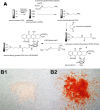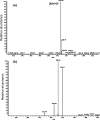Oxidized porous silicon particles covalently grafted with daunorubicin as a sustained intraocular drug delivery system
- PMID: 23322571
- PMCID: PMC3576052
- DOI: 10.1167/iovs.12-11172
Oxidized porous silicon particles covalently grafted with daunorubicin as a sustained intraocular drug delivery system
Abstract
Purpose: To test the feasibility of covalent loading of daunorubicin into oxidized porous silicon (OPS) and to evaluate the ocular properties of sustained delivery of daunorubicin in this system.
Methods: Porous silicon was heat oxidized and chemically functionalized so that the functional linker on the surface was covalently bonded with daunorubicin. The drug loading rate was determined by thermogravimetric analysis. Release of daunorubicin was confirmed in PBS and excised rabbit vitreous by mass spectrometry. Daunorubicin-loaded OPS particles (3 mg) were intravitreally injected into six rabbits, and ocular properties were evaluated through ophthalmic examinations and histology during a 3-month study. The same OPS was loaded with daunorubicin using physical adsorption and was evaluated similarly as a control for the covalent loading.
Results: In the case of covalent loading, 67 ± 10 μg daunorubicin was loaded into each milligram of the particles while 27 ± 10 μg/mg particles were loaded by physical adsorption. Rapid release of daunorubicin was observed in both PBS and excised vitreous (~75% and ~18%) from the physical adsorption loading, while less than 1% was released from the covalently loaded particles. Following intravitreal injection, the covalently loaded particles demonstrated a sustained degradation of OPS with drug release for 3 months without evidence of toxicity; physical adsorption loading revealed a complete release within 2 weeks and localized retinal toxicity due to high daunorubicin concentration.
Conclusions: OPS with covalently loaded daunorubicin demonstrated sustained intravitreal drug release without ocular toxicity, which may be useful to inhibit unwanted intraocular proliferation.
Conflict of interest statement
Disclosure:
Figures












Similar articles
-
Tunable sustained intravitreal drug delivery system for daunorubicin using oxidized porous silicon.J Control Release. 2014 Mar 28;178:46-54. doi: 10.1016/j.jconrel.2014.01.003. Epub 2014 Jan 11. J Control Release. 2014. PMID: 24424270 Free PMC article.
-
Hydrosilylated porous silicon particles function as an intravitreal drug delivery system for daunorubicin.J Ocul Pharmacol Ther. 2013 Jun;29(5):493-500. doi: 10.1089/jop.2012.0205. Epub 2013 Feb 28. J Ocul Pharmacol Ther. 2013. PMID: 23448595 Free PMC article.
-
A sustained dual drug delivery system for proliferative vitreoretinopathy.Drug Deliv. 2020 Dec;27(1):1461-1473. doi: 10.1080/10717544.2020.1833382. Drug Deliv. 2020. PMID: 33100053 Free PMC article.
-
Intravitreal nanoparticles for retinal delivery.Drug Discov Today. 2019 Aug;24(8):1510-1523. doi: 10.1016/j.drudis.2019.05.005. Epub 2019 May 16. Drug Discov Today. 2019. PMID: 31102730 Review.
-
Functionalized mesoporous silica particles for application in drug delivery system.Mini Rev Med Chem. 2012 Jul;12(8):775-88. doi: 10.2174/138955712801264855. Mini Rev Med Chem. 2012. PMID: 22512562 Review.
Cited by
-
Porous silicon oxide-PLGA composite microspheres for sustained ocular delivery of daunorubicin.Acta Biomater. 2014 Aug;10(8):3505-12. doi: 10.1016/j.actbio.2014.04.024. Epub 2014 May 2. Acta Biomater. 2014. PMID: 24793657 Free PMC article.
-
Oxidation-Induced Trapping of Drugs in Porous Silicon Microparticles.Chem Mater. 2014 Apr 22;26(8):2758-2764. doi: 10.1021/cm500797b. Epub 2014 Mar 20. Chem Mater. 2014. PMID: 25678746 Free PMC article.
-
Surface engineering of porous silicon microparticles for intravitreal sustained delivery of rapamycin.Invest Ophthalmol Vis Sci. 2015 Jan 22;56(2):1070-80. doi: 10.1167/iovs.14-15997. Invest Ophthalmol Vis Sci. 2015. PMID: 25613937 Free PMC article.
-
Exosomes-based dual drug-loaded nanocarrier for targeted and multiple proliferative vitreoretinopathy therapy.Regen Biomater. 2024 Jun 29;11:rbae081. doi: 10.1093/rb/rbae081. eCollection 2024. Regen Biomater. 2024. PMID: 39040514 Free PMC article.
-
Intravitreal safety profiles of sol-gel mesoporous silica microparticles and the degradation product (Si(OH)4).Drug Deliv. 2020 Dec;27(1):703-711. doi: 10.1080/10717544.2020.1760401. Drug Deliv. 2020. PMID: 32393079 Free PMC article.
References
-
- Pastor JC. Proliferative vitreoretinopathy: an overview. Surv Ophthalmol. 1998; 43: 3–18 - PubMed
-
- Turgut B, Uyar F, Ustundag B, Celiker U, Akpolat N, Demir T. The impact of tacrolimus on growth factors in experimental proliferative vitreoretinopathy. Retina. 2012; 32: 232–241 - PubMed
-
- Wiedemann P, Sorgente N, Bekhor C, Patterson R, Tran T, Ryan SJ. Daunomycin in the treatment of experimental proliferative vitreoretinopathy. Effective doses in vitro and in vivo. Invest Ophthalmol Vis Sci. 1985; 26: 719–725 - PubMed
Publication types
MeSH terms
Substances
Grants and funding
LinkOut - more resources
Full Text Sources
Other Literature Sources

